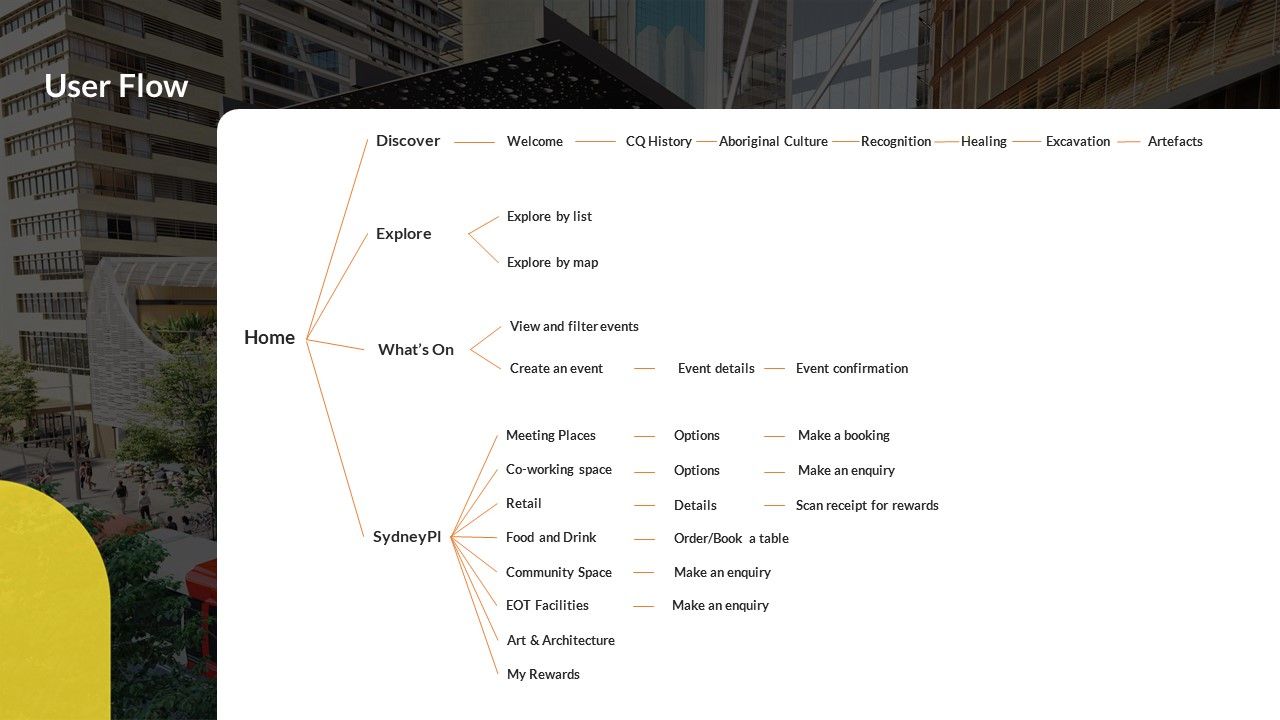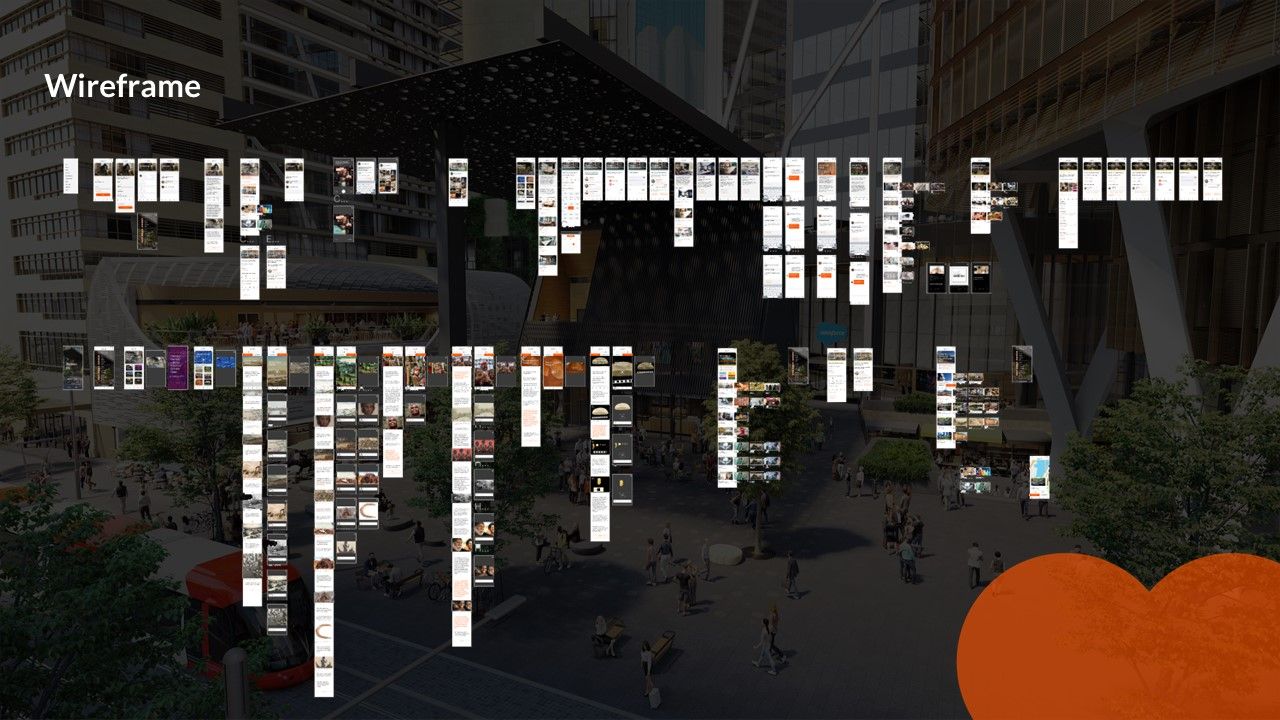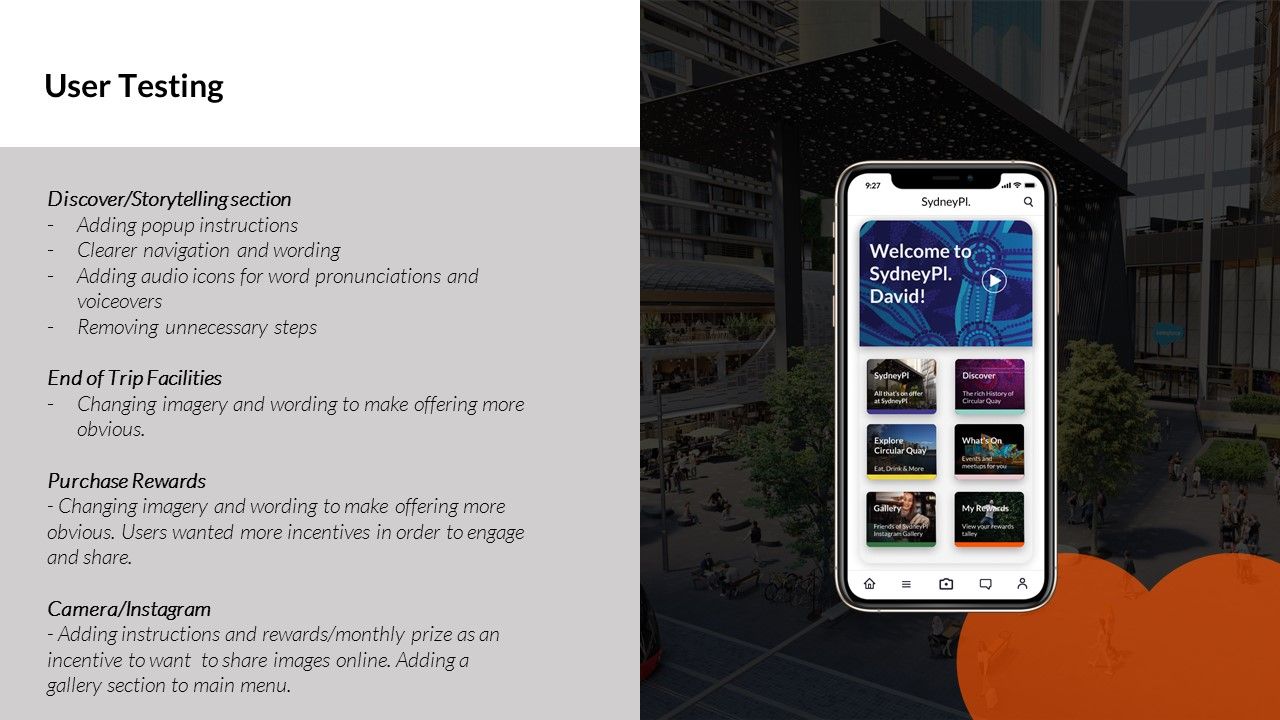A UX research and UI design project
What was I trying to solve?
Lendlease is developing a site known as Sydney Place. The public private partnership with the City of Sydney will deliver an increase in over a third more public space for the community including a public plaza, community building, retail laneways, public art, wellness facilities, bicycle hub, and a new hospitality venue on the site of the former ‘Jacksons on George’. The development will also be the home of Sydney’s tallest office building with CRM company Salesforce as the anchor tenant.
I was tasked with creating a Digital Experience that would not only showcase the history of the Circular Quay area, and in particular the Aboriginal Cultural significance, but to also create a lasting positive experience and way of building community within the precinct and office building.
My role and responsibilities
I collaborated with a team of designers to interview the key stakeholders and to define the problem we were trying to solve. Through user research I empathised with the user through interviews, creating personas and user journeys. Using Figma I designed a solution for the Digital Experience and tested this with users. The final solution was presented to the LendLease team for review.
Project Timeline
Start to finish: 9 weeks; a project-based learning experience for Lendlease.
Tools Used
Figma
Miro
Descript
What are the design challenges?
Based on the brief and the stakeholder interview, we uncovered the four key objectives which were:
Community
Community building platform, aiding collaboration between Salesforce (the main tenant of the building) and the innovation floor.
Storytelling
Educating about First Nations history. Bringing the truth and history to life, and creating an interactive digital showcase of the artefacts found on the site during excavation.
Awareness
More users, more traffic, more retail. Attracting new retail to the area, and in particular, promoting First Nations business and attracting them to area.
Experience
With limited opportunities in physical space and showcasing physical artefacts, a digital experience was required.
My approach
This project was guided by a User-Centred Design approach to understand exactly what motivates visitors and workers in the Circular Quay area, and to start to understand what they may be looking for in a Digital Experience.
This process moves through 5 key steps:

Empathise
with Circular Quay workers and visitors, to understand how they interact with Circular Quay. Stakeholder interviews, and Lean UX Canvas.
Define
and hone in on their needs through creating personas, mapping their journey, pains and gains, and defining the design opportunity.
Ideate
by creating ideas for how this could be solved, with sketches and user flow.
Prototype
the ideas that answer the Circular Quay workers and visitor needs through a clickable prototype.
Test
these designs with user tests, synthesis of the feedback, and refining and UX recommendations.
Empathising with user needs
I planned and conducted user interviews with workers and visitors to the Circular Quay area in Sydney. This was really great to talk to different people, and learn about different perspectives and values, and what motivated them.
- Users thought it would be helpful to be guided through the area, and what is on offer.
- They like the idea of a ‘Circular Quay app’ with a repository of information about the area.
- Users wanted real life stories, and a combination of text, images, audio, and video, for an interactive experience.
- Users liked the idea of learning small snippets of the Gadi language.
- Users wanted to have personalised and relevant information.
- Users wanted peer recommendations.
- During my user interviews I discovered that users liked to use Facebook or Meetup to find groups or events to build community around them, and share knowledge.
- Users wanted ways to make the options more digestible, or personalised.
- Users had some knowledge of Aboriginal culture, but also felt that the true history had not been explained.
- Users liked the idea of being able to learn, or ask (anonymous) questions to find.
User Personas
Primary Persona - Circular Quay Worker
Through user interviews and creating our primary worker persona, I developed a better understanding of our primary audience, including the goals, motivations, and frustrations.
By developing our worker user journey I gained a better understanding of the day in the life of a Circular Quay worker, including any touchpoints and opportunities to improve their experience.

Primary Persona - User Journey

Secondary Persona - Circular Quay Visitor
Through developing our visitor persona, I started to understand and empathise with the goals and frustrations from the point of view from the Circular Quay visitor.
I developed this further through user journey mapping, to understand how we can improve the Circular Quay experience for visitors and tourists.
I also uncovered opportunities for promotion and advertising of the final product, such as targeted ads on mobile, location based advertising, and location based push notifications for local deals and events.

Secondary Persona - User Journey

What was the UX opportunity?
How can the challenge become an opportunity?
After identifying the problems we were trying to solve, I framed ‘How might we statements’ to turn any challenges into opportunities:
- How can we tell the story and truth of the First Nations people and culture in an engaging and interactive way?
- How can we create community and engagement in an easy to use and personalised way?
- How can we create awareness and inform users of all that is on offer at SydneyPl, and in Circular Quay?
What is the landscape analysis?
Through research, I gained insight and inspiration from what was currently in the market. I found inspiration from other apps and websites that showcased cultural content in a unique and meaningful way.

Ideation
Through low resolution mockups, I explored ways of telling the story and history of Circular Quay, and how this might address user needs.

I explored ways of presenting all that is on offer at Circular Quay, and making it easy for people to navigate and find their way.

I looked at ways of creating community through groups and events, and how to make that information relevant and personalised.

Information Architecture
I then started to look at Information Architecture to visualise and understand how to best layout the content in terms of the best user flow for the user.
The user flow takes the user from their entry point through a set of steps towards a successful outcome and final action.
Final UX Solution

Let's work together
Let's work together to craft solutions that delight and inspire users.
I would love to have a chat, send me a message, or feel free to call on 022 627 5852 and let's talk.
About
UX and Product Designer who delivers thoughtful experiences. I would love to learn about your business and talk about how we can work together. Let's chat




